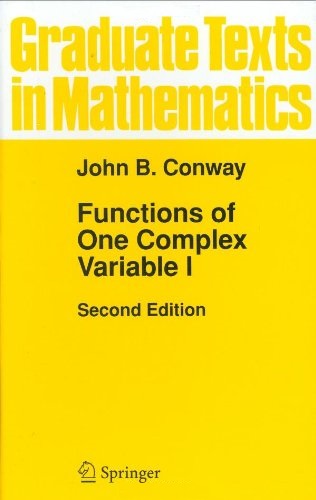
COURSE: MATH 5520
TIME: TBA TR; PLACE: TBA; CALL# 12228
INSTRUCTOR: Dr. Robert Gardner; OFFICE: Room 308F of Gilbreath Hall
OFFICE HOURS: TBA TR; PHONE: 439-6979 (Math Office 439-4349)
E-MAIL: gardnerr@etsu.edu
WEBPAGE: www.etsu.edu/math/gardner/gardner.htm (see my webpage for a copy of this course syllabus and updates for the course).
TEXT: Functions of One Complex Variable, Second Edition, by John Conway.

PREREQUISITE: Complex Analysis 1 (MATH 5510).
ABOUT THE COURSE: We continue our exploration of functions of a complex variable. We'll finish the results on complex integration, study singularities and Laurent series, and look at the various versions of the Maximum Modulus Theorem and some of its implications (not all of which are in the Conway book). If time permits, we will look at additional topics, such as metric spaces, Riemann surfaces, or applications.
OUTLINE:
Our tentative outline is:
Chapter 4. Complex Integration (continued): Zeros of analytic functions, Fundamental Theorem of Algebra, Maximum Modulus Theorem, winding number, Cauchy's Integral Formula, properties of path integrals, Open Mapping Theorem.
Chapter 5. Singularities: Classification of singularities, Laurent series, residues, integrals, meromorphic functions, argument principle, Rouche's Theorem.
Chapter 6. Maximum Modulus Theorem: Versions of Max Mod Theorem, Schwarz's Lemma,
Hadamard's Three Circles Theorem (maybe), Pragmen-Lindelof Theorem (maybe).
Other Possible Topics: Metric spaces (Chapter 2), Riemann zeta function (Section VII.8), Riemann surfaces (Chapter IX), applications of complex analysis results, research results on the location of zeros of a polynomial in terms of coefficients.
GRADING: Homework will be assigned and collected regularly. Grades will be assigned based on a 10 point scale with "plus" and "minus" grades being assigned as appropriate (based on grade points assigned by the university, on a plus/minus 3 point system). I expect that you will work together on the homework, but make sure that the work you turn in is your's and that you understand it. Your homework grade will also reflect how clearly you write up your solution and document your claims.
IMPORTANT DATES:
Monday, January 16 = Martin Luther King, Jr. Day, no class.
Monday, March 5 to Friday March 9 = Spring Break, no class.
Friday, April 27 = Last day of class.
OTHER RESOURCES. The following were mentioned in the Complex Analysis sequence:
HOMEWORK.The following homework is assigned:
Return to
Bob Gardner's webpage
Last Updated: April 26, 2012.